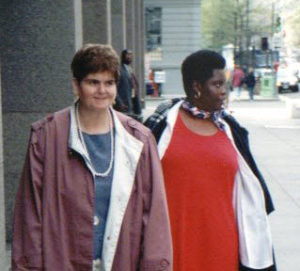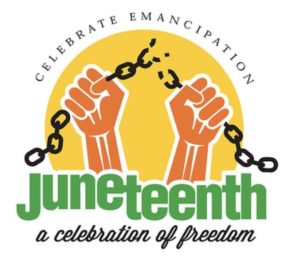 Finding the Perfect Place to Celebrate the 21st Anniversary of the Olmstead Decision | NAB
Finding the Perfect Place to Celebrate the 21st Anniversary of the Olmstead Decision | NAB
June 22 is the anniversary of Olmstead v. L.C. This landmark decision was a key part of civil rights protections by affirming that individuals with disabilities have the right to live in and receive care in their communities — rather than being forced to leave their home and families and live in institutions. The decision not only affirmed the promise of the only 9 years old ADA but seeks to make sure that institutionalization is not the only future for Americans with disabilities. In our latest blog looking back at the 21 years if the Olmstead decision, NAB Member Billy Altom tells us about the “perfect place” to recognize this important anniversary for civil rights.
Juneteenth
June 19 is the celebration of Juneteenth. Also known as Freedom Day, Jubilee Day or Liberation Day, Juneteenth marks the day when the news of the Emancipation Proclamation and the end of slavery reached the frontier of the western slave states. Although African-Americans in this part of the country had legally been freed for almost two and a half years, the news delivered by the Union Army that the War was over and slavery ended was the beginning of the next phase of life for many African-Americans, and a country that would have to come to grips with their presence, and our shared history in building this nation.
Juneteenth is usually marked by local celebrations that recognize a diverse and nuanced African-American culture celebrated in food, crafts and ceremony. An equally important part of the celebration is a reflection on the long road to freedom and the unique mixture of emotions of jubilation, and uncertainty that the news of freedom brings. This year’s recognition of Juneteenth will be even more poignant as protests against inequality continue, and advocates speak out about the perils of structural racism and intolerance that separates many Americans from life, liberty, and access to care. 155 years after that announcement in Texas, recent events have highlighted how the same feelings of uncertainty and questions of how if this Country can be fully accepting of all of its citizens still linger — especially in Black and Brown communities – making it seem as if we are still waiting for the word that freedom has arrived.
You can learn more about Juneteenth at https://www.pbs.org/…/african-a…/history/what-is-juneteenth/. We wish for you a safe and meaningful celebration of Juneteenth and join with those who advocate for freedom and inclusion for all.
Covid-19 deaths reveal ageist perceptions of seniors, which affects the care they receive | The Washington Post
Who dies of covid-19? If you answered “the elderly,” you’re right, according to the Centers for Disease Control and Prevention, which reports that 8 out of 10 of the people who have died of covid-19 in the United States so far were 65 and older. But that doesn’t mean older adults are weak.
Aging is a woman’s secret power — and the data proves it | NBC News
This advantage isn’t simply a feel-good rallying cry to give older women a self-esteem boost, but based on qualities and traits they develop over time. In less than 15 years, people aged 65 and up will outnumber those 18 and under for the first time in U.S. history. This major demographic shift presents a good opportunity for reevaluating our stereotypes and negative assumptions about getting older. Aging comes for us all, so it’s time to tune into its upsides, particularly for women.
Centering the Disability and Aging Communities in Federal Emergency Response Efforts | Center for American Progress
As the United States continues to grapple with the ongoing devastation of the coronavirus pandemic, it will also soon face extreme seasonal weather. From fires in the Southwest and the West to weather vortexes and floods in the Midwest to hurricane season in the South and the Southeast, the United States must prepare for upcoming disasters within the context of a global pandemic. Powerful hurricanes, heavy downpours, flooding, intense heat waves, and other extreme weather emergencies can endanger public health and safety, cause widespread damage, and make social distancing and stay-at-home orders impossible to implement. As shown throughout the COVID-19 response, older people and people with disabilities often feel the disproportionate effects of poorly handled national preparedness efforts. Unfortunately, these individuals have often been excluded from response strategies and emergency management at the federal level, despite comprising more than 25 percent of the U.S. population.
Violators Will Be Ticketed: Fighting Disability-Parking-Placard Fraud | Car & Driver
States and municipalities are looking for ways to shut down an active underground market for disability parking placards. Since the passage of the Americans with Disabilities Act in 1990, those ubiquitous blue parking permits have allowed drivers with disabilities to park in prime spaces, often for free and with no time limits. It didn’t take long for scammers to realize that disability placards could also be a valuable commodity for those whose only affliction is a distaste for following the rules. Across the country, the rampant illegal use of these placards makes life even more challenging for disabled drivers, as it leaves fewer spots available for those who need them.
In US, Older People, Minorities, Those with Health Issues Most Likely COVID Victims | Voice of America
Older people, minorities and those with pre-existing health conditions have been the most vulnerable to dying from COVID-19 in the United States, a new comprehensive study shows.
The Centers for Disease Control and Prevention (CDC) said Tuesday that the death rate in the United States for those who contracted the coronavirus was highest for those 80 years old and older, and lowest among children 9 years old and younger, according to the surveillance report, published in the CDC’s Morbidity and Mortality Weekly Report.
The Best (And Worst) States for Older Americans, Ranked | USA Today
The retirement-age population in the United States is projected to nearly double between 2018 and 2060. For many Americans entering their golden years, living somewhere that is warm — or perhaps closer to family — is a top priority. While preferences like these are by no means trivial, there are parts of the country where conditions for older Americans are objectively better.
Harvard professor seeks $100M to curb aging | Boston Business Journal
Harvard University scientist David Sinclair has made a name for himself as one of the leading researchers into how we can evade or stop the byproducts of aging. Now he’s hoping to raise $100 million to make it happen. Life Biosciences LLC has launched a new fundraising push one year after raising $50 million in a Series B financing, according to documents filed with the SEC. The 2019 round gave Life Biosciences a valuation of about $500 million.
Why virtual care will outlast the pandemic | Politico
An explosion of virtual care during the pandemic is raising expectations that Washington will make sure Americans can continue video chatting with their doctors after the health crisis subsides. Telehealth had been inching ahead for quite a few years, but it remained a niche industry amid a thicket of regulatory restrictions designed to combat potential fraud and high costs. That was until the pandemic hit and the Trump administration swiftly — though temporarily — knocked down many of those barriers, with states and private health insurers also expanding coverage of virtual care.
The Future Of Aging In America | Forbes
What does the future of aging in America look like? For answers, every year we ask some of our newest Influencers in Aging to offer their views at the American Society on Aging’s Aging in America conference. The pandemic turned this year’s in-person panel into a June 11 webinar, and the Influencers’ forecasts — as well as their laments — couldn’t have been timelier.
3 Ways Candidates Can Make A Real Difference On Disability Employment | Forbes
It’s not enough anymore for politicians to furrow their brows about the high rate of unemployment for people with disabilities. And “urging” employers “give disabled people a chance,” while all to the good, only goes so far. Government action alone can’t solve the problem. But there are specific policy changes that could help. If candidates want to earn disabled people’s votes, getting serious and creative about addressing structural barriers to disabled people’s employment goals would be a good start.
AAPD Statement on the Passing of Cheryl Sensenbrenner | AAPD
The American Association of People with Disabilities mourns the loss of Cheryl Sensenbrenner. The wife of Congressman Jim Sensenbrenner and former AAPD Board Chair, Cheryl’s leadership was critical to the advancement of AAPD and the cross-disability rights movement. She was particularly passionate about AAPD’s internship program and developing the next generation of disability rights leaders. Cheryl, who was a self-advocate, sibling-advocate, and parent-advocate, was a tireless champion for inclusion. Her tenacity and advocacy were critical to the passage of the Americans with Disabilities Amendments Act of 2008. In addition to her passion, she will be remembered for her humor and her charisma.
“Upon the recent passing of Cheryl Sensenbrenner, the global disability rights community lost one of our leading activists and agents for social reform and equal rights. Cheryl was a force of nature for positive change both on Capitol Hill and her native Wisconsin, where she hosted me for a whirlwind advocacy tour across the state, proving that our odd couple, Democrat and Republican, tag team can, in fact, be friends, work together, and collaborate and unite behind basic principles of justice and inclusion for all Americans. She never took “No” for an answer in her quest to build a society in which people with disabilities are valued equally and can participate fully – and I will be forever inspired by her example.” – AAPD Board Chair Ted Kennedy Jr.
Pride 50: Here are the Top 25 anthems of All Time | Miami Journal
The information and links provided here are a courtesy. The National Advisory Board does not necessarily endorse or share the views contained in any article, report or web site. No link provided here should be considered an endorsement of any opinion, product or service that may be offered in the article or at the linked-to site.

